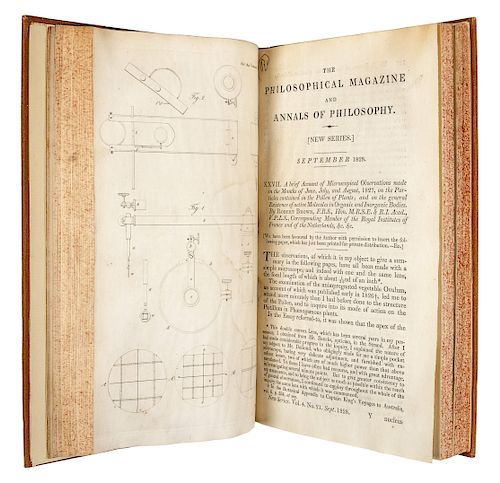BROWN, Robert (1773-1858). "A Brief Account of Microscopical Observations...on the Particles contained in the Pollen of Plants, and on the general Exi
Lot 8
About Seller
Hindman
1338 West Lake Street
Chicago, IL 60607
United States
Recognized as the Midwest's leading fine art auctioneers, Hindman Auctioneers has built a worldwide reputation based on a full service approach to the auction business tailored to meet the individual needs of our clients. Coming from a variety of educational backgrounds, specialists bring years of e...Read more
Categories
Estimate:
$1,500 - $2,000
Absentee vs Live bid
Two ways to bid:
- Leave a max absentee bid and the platform will bid on your behalf up to your maximum bid during the live auction.
- Bid live during the auction and your bids will be submitted real-time to the auctioneer.
Bid Increments
| Price | Bid Increment |
|---|---|
| $0 | $25 |
| $500 | $50 |
| $1,000 | $100 |
| $2,000 | $250 |
| $5,000 | $500 |
| $10,000 | $1,000 |
| $20,000 | $2,500 |
| $50,000 | $5,000 |
| $100,000 | $10,000 |
About Auction
By Hindman
Nov 5, 2019
Set Reminder
2019-11-05 11:00:00
2019-11-05 11:00:00
America/New_York
Bidsquare
Bidsquare : Library of a Midwestern Collector
https://www.bidsquare.com/auctions/hindman-auctions/library-of-a-midwestern-collector-4496
Hindman Bidsquare@hindmanauctions.com
Hindman Bidsquare@hindmanauctions.com
- Lot Description
BROWN, Robert (1773-1858). “A Brief Account of Microscopical Observations...on the Particles contained in the Pollen of Plants, and on the general Existence of active Molecules in Organic and Inorganic Bodies.” In: The Philosophical Magazine, New Series, Vol. IV, No. 21, pp. 161-173. London: Richard Taylor, September 1828.
FIRST PUBLISHED EDITION, preceded only by the scarce privately printed edition of the same year. “In 1927 Brown, while making microscopical observations, saw that pollen grains…while suspended in liquid, engaged in a continuous, haphazard, zig-zag movement… The idea that gases and liquids consist of molecules in rapid motion was not new, but it had remained largely speculative until it was scientifically proved and investigated in detail by Robert Brown and his followers” (PMM). “Brownian motion,” as his discovery was subsequently named, formed the basis for kinetic theory of gases, and served as proof of the existence of atoms and molecules. “To Brown belongs the credit for establishing such motion as a property not simply of living pollen but of all minute particles, inorganic as well as organic, suspended in a fluid” (DSB). Dibner Heralds 156; Norman 354; PMM 290 (the privately printed edition). [With:] BROWN. “Additional Remarks on Active Molecules.” In: The Philosophical Magazine, New Series, Vol. VI, No. 33, pp.161-166. London: Richard Taylor, September 1829. FIRST EDITION, in which Brown remarks that he is unable to account for the Brownian motion he previously observed before renouncing several recent hypotheses. Together, 2 journals, 8vo. Numerous engraved plates, in-text diagrams and illustrations. (Lower marginal dampstaining to a few leaves, some scant spotting.) Uniform modern quarter tan calf. Provenance: Glasgow Philosophical Society (stamps on title-page and a few discreet pencil markings to Vol. 4); George Speri Sperti (1900-1991) American inventor (stamp on p. 35 in Vol. 6).
For condition inquiries please contact Gretchen Hause at gretchenhause@hindmanauctions.comCondition
- Shipping Info
-
Please refer to https://hindmanauctions.com/shipping-packing
-
- Buyer's Premium



 EUR
EUR CAD
CAD AUD
AUD GBP
GBP MXN
MXN HKD
HKD CNY
CNY MYR
MYR SEK
SEK SGD
SGD CHF
CHF THB
THB












